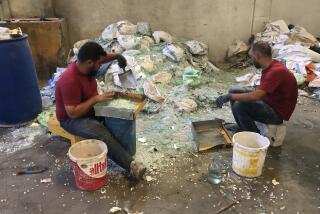Father-Son Design Team Fights Setbacks in Tackling Tough Glass Recycling Snags : Manufacturing: Quest for economic way to sort through colors and extraneous materials proves elusive.
- Share via
EUGENE, Ore. — A small father-son design firm called Alpine Technology is looking for answers to questions that have vexed glass recyclers and manufacturers worldwide for decades.
Is there a better way to separate used bottles of different colors, other than sorting by hand? And how can manufacturers remove materials, such as ceramics, that can cause defects in new containers made from old glass?
Like others who have sought the solutions, the firm’s founders Tom and Jim Mitchell are having a tough time.
With extensive financial help from the federal government and the state of Oregon, the pair designed a machine that removes contaminants and sorts glass by color. But the project--which has cost about $750,000 so far--has hit snags after a trial run at a Pennsylvania recycling center. And the Mitchells say they’re running out of money.
Alpine is one of many firms in the United States and Europe looking for better ways to sort the mountains of waste bottles and other glass produced by beverage-happy communities. Glass companies can make new containers using 75% to 80% recycled content. But many use less than that because they don’t receive enough usable old glass.
If successful, technologies such as Alpine’s could save energy because glass manufacturers could cut their furnace temperatures. Making glass from scratch requires higher heat than re-melting old glass. Experts say the technologies also could boost the nation’s 37% glass recycling rate and reduce waste buried in landfills.
And the Mitchells say their machine has the potential to do that.
Two years ago, they installed an early prototype at a recycling center in San Rafael, and have been tinkering with the technology ever since.
Last October, they entered an agreement with equipment company Clarion Envirotech to install an advanced model at a recycling center in Clarion, Penn.
The 20-foot-long machine feeds glass by conveyor to an optical scanner. When the sensor identifies non-recyclable material, it blows the piece out of the stream with a burst of compressed air. The same system sorts glass by color.
But problems--mostly with the scanner--soured the deal with Clarion Envirotech.
“The machine does not function,” said Larry Kifer, a Clarion Envirotech owner. “It will not do what they said and it never will, in my opinion.”
Kifer said he plans to sell Alpine’s machine for parts and has installed different equipment, which he declined to describe.
Jim Mitchell countered Kifer’s complaints, saying Alpine’s sorter performed according to the contract. He said Kifer knew from the start that the equipment required more research.
Jim Mitchell admits, however, there are bugs in the optical scanner. The 35-year-old mechanical engineer said he’s confident they can be fixed, though.
Alpine has enlisted research help from Oregon State University, as well as Battelle Pacific Northwest Laboratories, a research and development firm in Richland, Wash.
If Battelle finds a solution, Alpine Technology will pay the firm royalties on each machine it sells, Jim Mitchell said.
If the equipment is perfected, the Mitchells plan to market it in the northeastern United States and overseas, especially to the island countries along the Pacific Rim, where landfill space is scarce.
The machine would sell well in communities that don’t sort glass by color when it’s collected, said Peter Spendelow, a waste-reduction specialist with the state Department of Quality in Salem.
More to Read
Inside the business of entertainment
The Wide Shot brings you news, analysis and insights on everything from streaming wars to production — and what it all means for the future.
You may occasionally receive promotional content from the Los Angeles Times.








